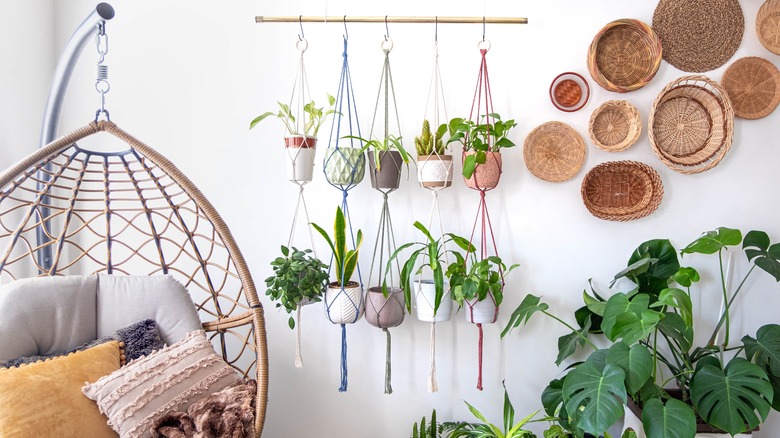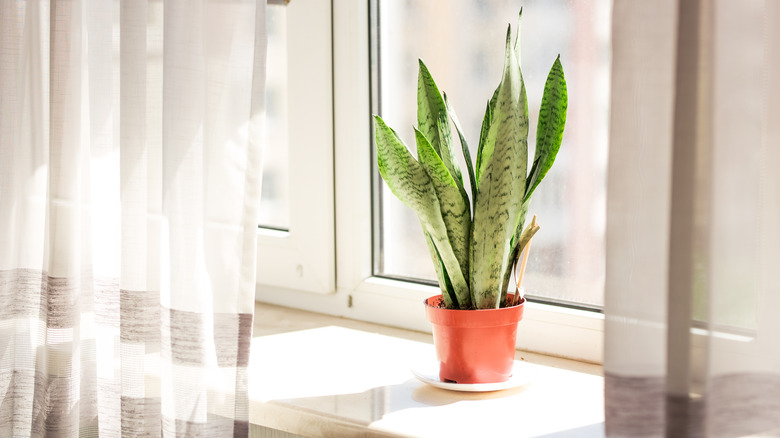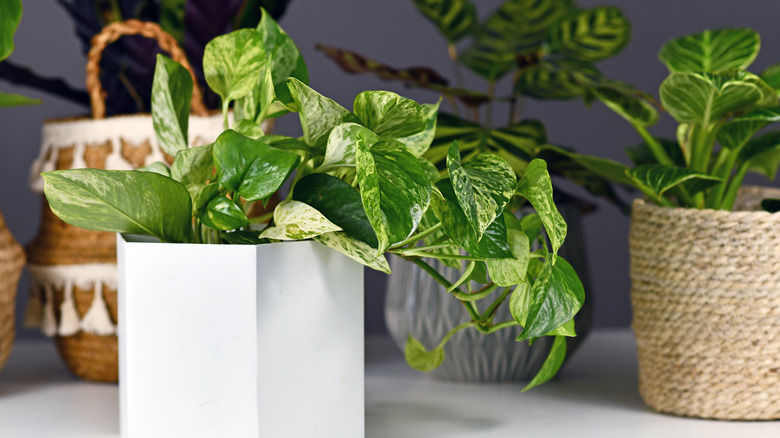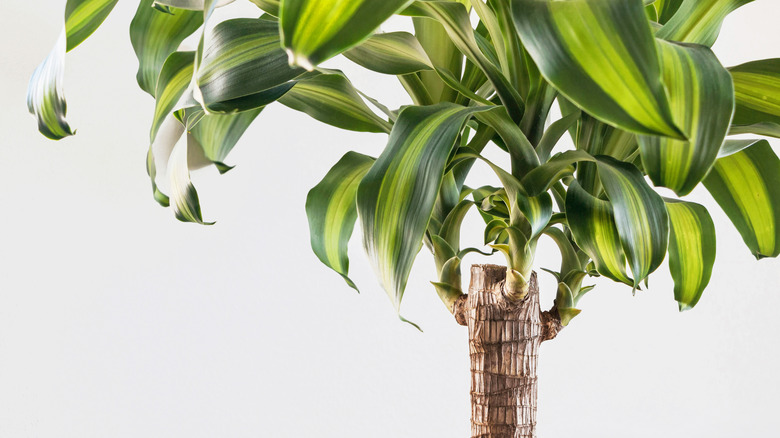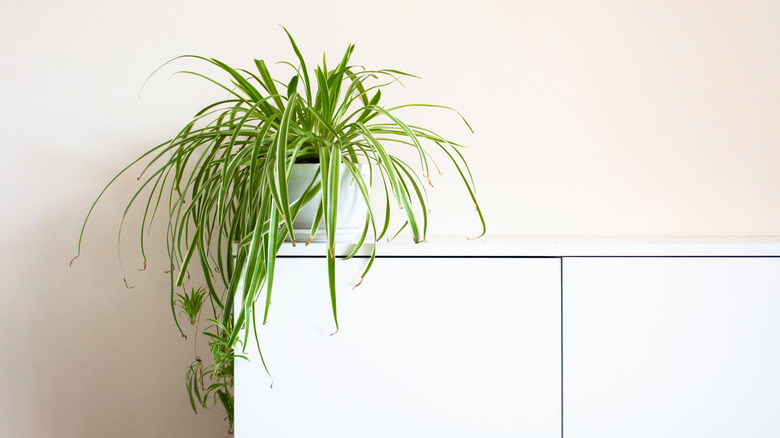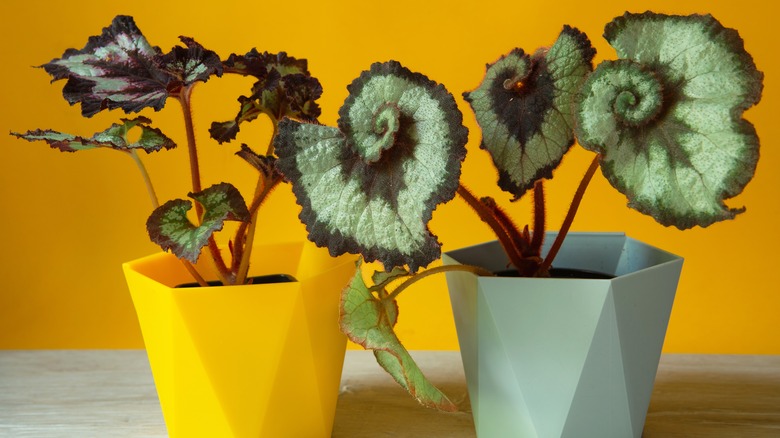5 Houseplants You Can Grow In Low Light
If you swoon over Instagram images of rooms full of houseplants but struggle to keep one straggly aloe vera alive, there is still hope to make your indoor jungle dreams come true. Unfortunately, when shopping for houseplants, most people tend to buy what they like without considering their home-growing environment. After a few dead, and sometimes expensive, plants, it's easy to believe you have a black thumb, but you don't — you just need to buy the right varieties. While some plants require bright light, many thrive in low-light conditions, and some even grow in an artificial light environment.
Sure, houseplants are pretty, but they have health benefits as well. According to Piedmont, they remove carbon dioxide and harmful chemicals from the air, replacing them with pure oxygen, and just their presence in the home can improve your overall sense of well-being. In addition, while houseplants are known to reduce stress, they will have the opposite effect if you are struggling to keep them alive in low-light conditions. By selecting the right species for your space, you gain all the benefits of beautiful indoor plants without the struggle to keep them alive. Here are five cultivars that thrive in low-light conditions.
1. Sansevieria
Sansevierias (Dracaena trifasciata), also known as the snake plant, tolerates almost any lighting conditions, making it perfect for any room of the house. Do you often forget to water your greenery? If so, this is a great option for you because these guys do not like wet feet — also known as soggy soil conditions. If you give them to drink too often, the roots will rot, so the best strategy for caring for a snake plant is to water when the soil is dry a few inches below the surface, states Joy Us Garden. Sansevierias also tolerate low humidity.
One of the best things about the snake plants is their unusual growth habit. This greenery will add visual interest and texture to your décor with upright, variegated, succulent-like leaves. They also offer a unique health benefit. Healthline states that, unlike most plants, they continue to turn carbon dioxide into oxygen at night, making them perfect for the bedroom. Consider this popular and hardy variety if you have a space with low light or lots of light. It's probably best just to get one for every room.
2. Pothos
Whether you are just getting started on your indoor garden or need something to help restore your plant-growing self-esteem, buying a pothos (Epipremnum aureum) is the perfect place to start. Pothos is also known as devil's ivy, but don't let that put you off because this flora is a saint when it comes to removing indoor pollutants like formaldehyde and benzene while remaining low-maintenance, according to the University of Wisconsin-Madison.
Pothos is a groundcover in its native tropical regions, meaning it is an understory plant used to shady conditions. Although it does not tolerate full sun, pothos can grow in medium-to-low light conditions. This plant can even thrive in spaces like offices where there is only artificial light. This houseplant can be pruned to keep a bushy appearance, or its long vines can be trained up a small trellis. To keep your pothos healthy, water when the soil is dry and do not over-water.
3. Corn plant
If you are looking to add height and interest to your home décor, the corn plant (Dracaena fragrans) is a great option. Although they come in various sizes, they can grow up to 6 feet tall indoors, making them perfect for brightening up a boring corner of your room. Corn plants are also exceptional for cleaning the air. In fact, they were included in a NASA study that identified 18 houseplants that effectively remove indoor pollutants ranging from cigarette smoke to radon, per NASA STI Repository.
Don't let their size fool you; corn plants are especially low-maintenance. House Plants Expert states they like moist, well-draining soil and have no specific humidity requirements. They are relatively slow growers, so there is minimal pruning. Because they are tropical plants, it's best to keep them away from cold drafts, but otherwise, these guys just like to be left alone. So give them a cozy corner, a bit of water, and fertilizer, and enjoy their beauty.
4. Spider plant
Spider plants (Chlorophytum comosum) are commonly found in offices and commercial buildings, but there is a reason they are so widely used — they are easy to grow! Spider plants are also known as airplane plants and are often grown in hanging planters, but they also make nice tabletop greenery, according to Costa Farms. The benefit of growing them in hanging baskets is the interesting texture added when they produce stems with plantlets that can be left on or trimmed off and propagated to make a new plant.
Spider plants grow in low to bright lighting and are non-toxic to humans and pets, making them a safe addition to a pet-friendly home. They require minimum maintenance and tolerate dry soil if you forget to water them occasionally. Because they are so easy to grow, spider plants can be cultivated almost anywhere in your house or even in an office with artificial light.
5. Rex begonia
Known for their colorful foliage, rex begonias (Begonia rex-cultorum) are stunning plants that will brighten any area of your home with low or artificial lighting, states Smart Garden Guide. The family of rex begonias is vast and includes many colors, leaf shapes, and sizes, so you can find something to work with your home décor. Available varieties come in shades of purple, yellow, silver, white, and even orange. Some rex begonias get up to 2 feet tall, while others are more compact. The leaves of some members of this family of houseplants are flat, while others are a beautiful ruffle shape. When shopping for these beauties, it is important to read the label to ensure you know what you are getting in size, color, and growing requirements.
Desirable growing conditions for these beautiful plants are pretty simple. They thrive in typical indoor temperatures between 60 and 85 degrees Fahrenheit and just need to be watered when the soil is dry, probably about once a week. Because they are tropical plants, rex begonias like higher-than-normal humidity, so if your home gets dry over the winter, a humidifier or a spritz with a mister a few times a week should help keep your plants happy.
